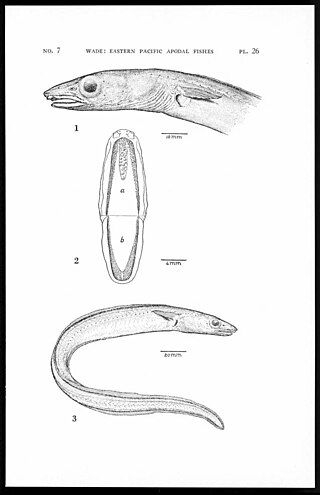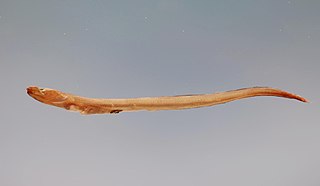
Apterichtus is a genus of fish in the family Ophichthidae. Many of its species are called finless eels.

Moringua edwardsi, the common spaghetti eel, is an eel in the family Moringuidae. It was described by David Starr Jordan and Charles Harvey Bollman in 1889, originally under the genus Stilbiscus. It is a subtropical, marine eel known from the western Atlantic Ocean, including Antigua and Barbuda, Aruba, the Bahamas, Barbados, Belize, Bermuda, Cuba, Dominica, Grenada, Guadeloupe, Honduras, Jamaica, Martinique, Mexico, Montserrat, Nicaragua, Puerto Rico, Saint Kitts and Nevis, Saint Lucia, Saint Vincent and the Grenadines, Trinidad and Tobago, Florida, Venezuela, the Virgin Islands, British, and the Virgin Islands of the United States. Males can reach a maximum total length of 15 cm, while females can reach a maximum of 50 cm. The eels feed primarily off of burrowing invertebrates.
The Gilbert's garden eel, also known as the Gilbert's conger and the sharpnose conger, is an eel in the family Congridae. It was described by James Douglas Ogilby in 1898, originally under the genus Congrellus. It is a tropical, marine eel which is known from the eastern central and southeastern Pacific Ocean, including the Gulf of California, Costa Rica, El Salvador, Ecuador, Guatemala, Mexico, Honduras, Nicaragua, Panama, and Colombia. It is a benthic and nocturnal species, and inhabits sand flats in reefs, bays and coves at a depth range of 1–100 metres. It burrows into sand during the day and emerges to forage during the night. Males can reach a maximum total length of 27 centimetres.
The slope conger, also known as the black-fin conger, is an eel in the family Congridae. It was described by Charles Henry Gilbert in 1891, originally under the genus Ophisoma. It is a marine, deep water-dwelling eel which is known from the southeastern and eastern central Pacific Ocean, including Colombia, Ecuador, Costa Rica, Honduras, El Salvador, Mexico, Guatemala, Nicaragua, Panama, and Peru. It is known to dwell at a depth range of 380–740 metres, and inhabits substrates. Males can reach a maximum total length of 35 centimetres.
The neighbor conger is an eel in the family Congridae. It was described by Samuel Garman in 1899, originally under the genus Uroconger. It is a marine, deep water-dwelling eel that is known from the southwestern and western central Atlantic Ocean, including the Bahamas, Brazil, Cuba, and Mexico. It dwells at a depth range of 101–503 metres. Males can reach a maximum total length of 46.2 centimetres.

Gnathophis cinctus, the hardtail conger or Catalina conger, is an eel in the family Congridae. It was described by Samuel Garman in 1899, originally under the genus Atopichthys. It is a tropical, marine eel which is known from the eastern central and southeastern Pacific Ocean, including Chile, Colombia, Costa Rica, Ecuador, El Salvador, Guatemala, Honduras, Mexico, Nicaragua, Panama, Peru, and the United States. It dwells at a depth range of 9–336 metres, and leads a benthic lifestyle, burrowing into loose sand. Males can reach a maximum total length of 42 cm.

The red pike conger is an eel in the family Muraenesocidae. It was described by David Starr Jordan and Charles Henry Gilbert in 1882, originally under the genus Muraenesox. It is a marine, tropical eel which is known from the eastern central and southeastern Pacific Ocean, including Mexico, Ecuador, Colombia, Costa Rica, Guatemala, El Salvador, Honduras, Panama, Peru, and Nicaragua. It dwells at a depth range of 10 to 100 metres, and inhabits sediments of sand and mud. Males can reach a maximum total length of 202 centimetres (80 in); the maximum recorded weight is 11.0 kilograms (24.3 lb).
The Pacific worm eel is an eel in the family Ophichthidae. It was described by David Starr Jordan and Charles Henry Gilbert in 1883. It is a marine, subtropical eel which is known from the eastern central and southeastern Pacific Ocean, including California, USA, Colombia, Costa Rica, El Salvador, Ecuador, Honduras, Mexico, Guatemala, Panama, Nicaragua, and Peru. It dwells at a depth range of 1 to 12 metres, and inhabits sand and mud sediments. Unlike many species of eel, it does not form burrows. Males can reach a maximum total length of 46 centimetres.

Apterichtus caecus, the European finless eel, is a species of snake eel native to the eastern Atlantic Ocean, from the Azores to the Gulf of Guinea, and into the western Mediterranean including the Balearic Islands. It can be found on the continental shelf at depths of from 10 to 40 metres living in burrows in mud or sand. It preys on other fishes as well as benthic invertebrates. Spawning for this species in the Mediterranean has been recorded in the early summer months of May and June. This species can reach a length of 60 centimetres (24 in) TL.
Apterichtus equatorialis, the finless eel or equatorial eel, is a species of snake eel native to the eastern Pacific Ocean, from the Gulf of California to Panama and around the Galapagos Islands. This species can be found at depths of from 106 to 125 metres inhabiting areas with bottoms of sand or mud. This species can reach a length of 27 centimetres (11 in) TL.
The Indifferent eel is a species of eels in the family Ophichthidae. It was described by John E. McCosker and James Erwin Böhlke in 1984. It is a marine, tropical eel which is known from the western central Atlantic Ocean, including Panama, Nicaragua, Suriname, and Texas, USA. It dwells at a depth range of 55 to 58 meters.
The smiling snake eel is an eel in the family Ophichthidae. It was described by David Starr Jordan and Charles Henry Gilbert in 1882, originally under the genus Apterichthys. It is a marine, tropical eel which is known from the eastern central and southeastern Pacific Ocean, including Colombia, Costa Rica, Panama, Ecuador, and Mexico. It dwells at a maximum depth of 30 metres (98 ft), and inhabits sediments of sand. Males can reach a maximum total length of 41 centimetres (16 in).
The Oriental worm-eel, also known as the Oriental snake eel, the Oriental sand-eel or the finny sand-eel, is an eel in the family Ophichthidae. It was described by John McClelland in 1844, originally under the genus Dalophis. It is a tropical, marine and freshwater-dwelling eel which is known from the Indo-Western Pacific, including Somalia, South Africa, India, Papua New Guinea, Tahiti, French Polynesia, Indonesia, Oman, Palau, New Caledonia, the Philippines, Sri Lanka, Seychelles, and Vanuatu. It dwells at a depth range of 0 to 3 metres, and forms burrows in sand and mud sediments in estuaries, rivers, and inshore turbid waters. Males can reach a maximum total length of 36 centimetres (14 in), but more commonly reach a TL of 25 centimetres (9.8 in).
The death-banded snake eel is an eel in the family Ophichthidae. It was described by Samuel Garman in 1899. It is a tropical, marine eel which is known from the eastern central and southeastern Pacific Ocean, including the central Gulf of California, Colombia, Costa Rica, Mexico and Panama. It dwells at a depth range of 35–760 metres, and forms burrows in sandy and muddy bottoms. Males can reach a maximum total length of 86 centimetres.

The blackpored eel is an eel in the family Ophichthidae. It was described by Robert H. Kanazawa in 1963. It is a tropical, marine eel which is known from the western central Atlantic Ocean, including Florida, USA; the Bahamas, and Mexico. It dwells at a depth range of 51–460 meters. While the adults inhabit deep water, the larvae are laid inshore. Males can reach a maximum total length of 70 centimeters.
The yellow snake eel is an eel in the family Ophichthidae. It was described by David Starr Jordan and Charles Henry Gilbert in 1882. It is a marine, subtropical eel known from the eastern central and southeastern Pacific Ocean, including Chile, Costa Rica, Colombia, Ecuador, Guatemala, El Salvador, Honduras, Nicaragua, Mexico, Panama, Peru, and the United States. It dwells at a depth range of 1 to 110 m, and forms burrows in rocky and sandy regions. Males can reach a maximum total length of 818 cm (322 in), but more commonly reach a length of 540 cm (210 in).
The smallfish snake eel is an eel in the family Ophichthidae. It was described by Charles Henry Gilbert in 1890. It is a marine, tropical eel which is known from the eastern central Pacific Ocean, including Mexico, Nicaragua, Panama, the Gulf of California and Costa Rica. It dwells in shallow waters at a maximum depth of 20 metres (66 ft), and inhabits sand and rock sediments. Males can reach a maximum total length of 70 centimetres (28 in).
The short-tooth sawpalate is an eel in the family Serrivomeridae. It was described by Johannes Schmidt in 1916, originally under the genus Leptocephalus. It is a marine, deep water-dwelling eel which is known from the eastern central and western central Atlantic Ocean, including the Bahamas and Bermuda, as well as the Strait of Gibraltar, Cape Verde, Canada and the United States. It dwells at a depth range of 150 to 1,000 metres. Males can reach a maximum total length of 65 centimetres (26 in).
The Kaup's arrowtooth eel is an eel in the family Synaphobranchidae. It was described by James Yate Johnson in 1862. It is a marine, deep water-dwelling eel which is known from the Indo-Western Pacific and eastern and western Atlantic Ocean, including the Faroe Islands, Iceland, Cape Verde, the Western Sahara, Nigeria, Namibia, South Africa, Greenland, France, Saint Pierre and Miquelon, the United Kingdom, Ireland, the Philippines, Portugal, Spain, the Bahamas, Brazil, Canada, Cuba, Japan, Australia, Mauritania, Morocco, and Hawaii. It dwells at a depth range of 120 to 4,800 metres, most often between 400 and 2,200 metres, and inhabits the upper abyssal zone on the continental slope. It is intolerant of the temperatures of higher waters. Males can reach a maximum total length of 100 centimetres (39 in).
Finless eel is a common name for several fishes and may refer to:




